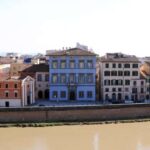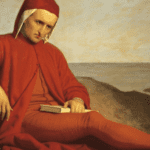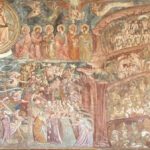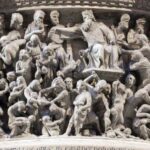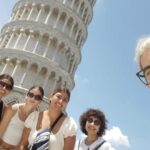The Gothic in Pisa: The Piazza dei Miracoli. Despite the predominance of the Pisan Romanesque style that reflects the splendor of the city’s golden age, we have in the architecture valid examples of the style that will be in vogue in subsequent years.
The Gothic style was born in France in 1144 with the construction of the Abbey of Saint-Denis which had a lighter structure than the massive Churches of the previous Romanesque period.
In fact, one of the characteristics of Gothic architecture is that the weight of the building is no longer absorbed by the thick walls, but distributed on internal pillars and external elements such as rampant arches and pinnacles.
Gothic in Italy
In Italy the term Gothic was introduced by Giorgio Vasari in the sixteenth century to define a ‘Nordic, barbaric’ art as opposed to the resumption of the Roman elegance of the Renaissance.
In Western Europe this style finds its most relevant expression in architecture. This is characterized by a bold new construction technique, based on the exploitation of already known architectural elements (the sharp arch and the ribbed vault). For the first time they are coordinated in order to always give greater elevation and vertical momentum to the building.
Gothic in Pisa
The period of greatest development goes from the twelfth to the fifteenth century, golden centuries also for the city of Pisa which is then still a powerful Maritime Republic.
Let’s analyze some buildings in the city that represent the characteristics of this architectural style starting from the most famous square: the Piazza del Duomo, better known as the Piazza dei Miracoli, from where our tours start.
The Square of Miracles
At first glance we can see that the style that predominates is the Pisan Romanesque one with blind arches and the alternation of light and dark marbles, but if we take a closer look we see that the Gothic one is also present in almost all monuments.
All the buildings were started between the tenth and thirteenth centuries and therefore maintain the homonymous style of the city, but over the years we want to adapt to the ‘new fashion’ and this is especially noticeable in the buildings that were finished in the following centuries.
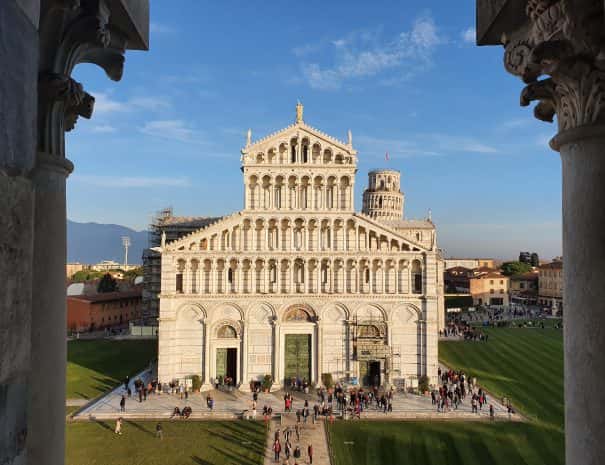
The Cathedral of Santa Maria Assunta
Let’s start with the oldest and most main building in the square: the Cathedral of Santa Maria Assunta. The construction of the Cathedral began in 1063 by the architect Buscheto and was completed (in just) 117 years, but it can be noted that many of the finishes are posthumous.
To find the Gothic style we have to look up and focus on the highest part, in fact at the intersection of the longitudinal body and the transept of the Church rises the wide and majestic elliptical dome!
Its structure, which rests on an octagonal drum, is contextual to the other parts of Buschet, while the strengthening at the base with a series of arcons and embellished by an elegant cuspidate loggia is from 1380 by Lupo di Gante and Puccio di Gadduccio.
The Baptistery of St. John
Even in the second (by age) monument of the square we have a Romanesque and a Gothic phase.
In the Baptistery of St. John the Gothic level we can better recognize it, in fact the entire second order presents its peculiar characteristics: rich sculptural decoration, theory of eardrums, cusps and pinnacles.
The Baptistery which you can visit inside with our tour of the Miracles was founded in 1152 under the direction of the architect Diotisalvi who deals with the first order in the Pisan Romanesque style.
After a pause and therefore the interruption of the work, we see at work two of the most brilliant architects/sculpturers of the thirteenth and fourteenth centuries: Nicola and Giovanni Pisano, father and son.
From 1260 Nicola and his workshop, of which his son and Arnolfo di Cambio were also part, began to work on the open arched gallery with the overlying triangular vimperghe containing busts of Saints and Prophets and surmounted by a level of mulled harps alternating with angular parasades crowned by archiacute cuspidi.

The Monumental Cemetery
In the Monumental Cemetery, which has a very simple decoration, stands out a Gothic aedicule of the master Lupo di Francesco, which overlooks the second door of the building.
This is richly decorated according to Gothic fashion: inside it hosts a sculptural group depicting the Madonna and Child, two angels, two unidentified saints and a kneeling devotee (most likely the client Giovanni Rossi); the upper cusps have a tunnel work and are surmounted by statuettes including the David and two prophets; three pyramidal pinnacles with double lily ends overlook the entire structure.
The interior also has an architecture that follows the same style, in fact the four galleries are illuminated by a series of arches that include four-frames consisting of rosettes and intertwined arches.
